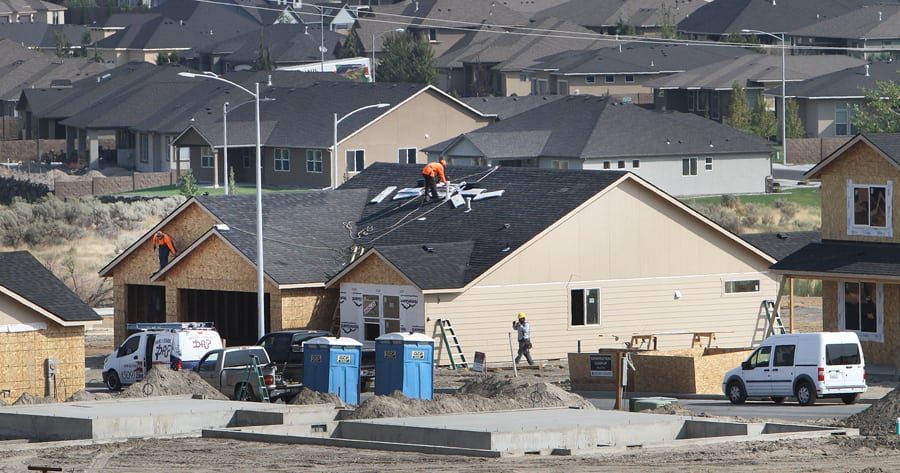
Tri-City homes out of reach for many at current prices
Don’t expect to see explosive growth in Tri-City residential
and commercial sectors in the coming year.
That was the message from a panel of industry experts on a Building the Tri-Cities panel at the Tri-City Development Council’s March 28 annual economic outlook meeting in Pasco. TRIDEC postponed the event a month due to February’s snow.
The Tri-City residential housing market continues to be
tight, especially for homes under $300,000.
“We have a very top-heavy market and affordable homes
underneath $300,000 simply just don’t exist,” said Jeff Smart, past president
of the Tri-City Association of Realtors and treasurer of the state association
of Realtors. He also owns Smart Realtors of Richland.
Smart said only a dozen homes priced under $200,000 were
move-in ready in the Tri-City market — which includes Benton City and West
Richland, with the total available numbering 308.
He said 40 percent of the available homes were $400,000 and
up.
“Seventy-six percent of those homes are above $300,000, so
we do have an affordable home issue in our market right now. And we also have
that same issue across the state,” Smart said.
The area’s housing appreciation rate has averaged about 10
percent, Smart said, explaining that a home valued at $200,000 the year before
is now worth $210,000.
“It’s a pace we probably can’t sustain for too long,” he
said, forecasting in the coming year a leveling off of appreciation rates, flat
sales and availability of fewer higher-priced homes. He was careful not to call
the trend a market crash, but a “little bit of a correction.”
“Of course I could be wrong. My crystal ball broke yesterday
morning,” he quipped.
Commercial brokers are feeling optimistic about the coming
year, said Charles Laird, real estate broker for Pasco’s Tippett Co., a
family-owned real estate business celebrating its 50th anniversary this year.
He said most clients want to “dial right into Columbia
Center mall area,” as it’s become the Tri-City’s central business district, as
communities continue to morph away from their downtown cores.
He defined the area as between Gage Boulevard, Columbia
Center Boulevard, Vista Field and Clearwater Avenue.
Development has stabilized in Richland’s Queensgate Drive
area and Pasco’s Road 68 corridor thanks to big box retailers like Walmart, and
Kennewick’s Southridge area with the consolidations in the medical field, he
said.
But emerging markets are poised for growth, he said,
pointing to Badger Mountain South and Road 100.
“There’s still a lot of the new development activity coming
down the pike,” he said.
The Tri-City’s inventory of office and retail space has gradually
increased from 2016 to 2018, with Benton County boasting “way more office and
retail space than Franklin County,” Laird said.
Leasing trends showed 413,437 square feet of available
office space in December 2018, compared to 362,416 square feet the prior year.
On the retail side, there was 462,583 square feet of available retail space,
compared to 406,589 square feet the prior year. Laird pointed out that most of
the inventory was Class B and C property.
Property classifications fall into A, B and C categories,
with A typically being the highest quality, most expensive and in the most
desirable locations.
He said the latest vacancy rates show 5 percent vacancy for
Class A properties, 15 percent for Class B and 25 percent for Class C. But he
added that it’s hard to track Tri-City vacancy rates because it’s a small
market.
The Tri-Cities showed 30 office property listings on Pacific
Regional Multiple Listing Service on April 9, totaling 254,939 square feet,
valued at more than $38 million and 21 retail listings with 211,426 square
feet, valued at more than $36 million. These numbers don’t include properties
listed by owner or elsewhere, Laird said.
In the past five
years, the Tri-Cities added 6.5 million square feet of new construction across
all real estate sectors.
Projected new
construction for 2019 totals 2.9 million square feet. Of that, about 230,000
square feet will be new office and retail buildings, Laird said.
“There’s still holes
to be filled in some of the submarket areas … I think we’ll just keep trucking
along. I don’t see it being too fast or too slow,” Laird said.
Jeff Losey, executive
director of the Home Builders Association of Tri-Cities, said he expects this
year to look a lot like 2018.
In 2018, there were
1,466 single-family home permits issued, compared to the previous year’s 1,446.
Permits are issued for homes to be built.
“It’s just over a 1
percent increase. It’s predictably what we thought would happen in our market,”
Losey said.
Pasco led the way
with a third of all permits pulled in the entire Tri-Cities with developments
along roads 100 and 68 continuing to “be a very hot area for Tri-Cities, as far
as growth is happening,” Losey said.
But a nationwide
economic slowdown is approaching, Losey said, pointing to a chart from the U.S.
Bureau of Economic Analysis and National Association of Home Builders.
Gross domestic
product growth is projected to be 2.5 percent this year and 1.3 percent in
2020. That’s compared to 2.9 percent growth in 2018, he said.
“Yes, the builders
are expecting things will slow down in the Tri-Cities based on what you’re
seeing. Things are slowing down more because we don’t have enough lots
available and/or qualified skilled labor,” Losey said.
